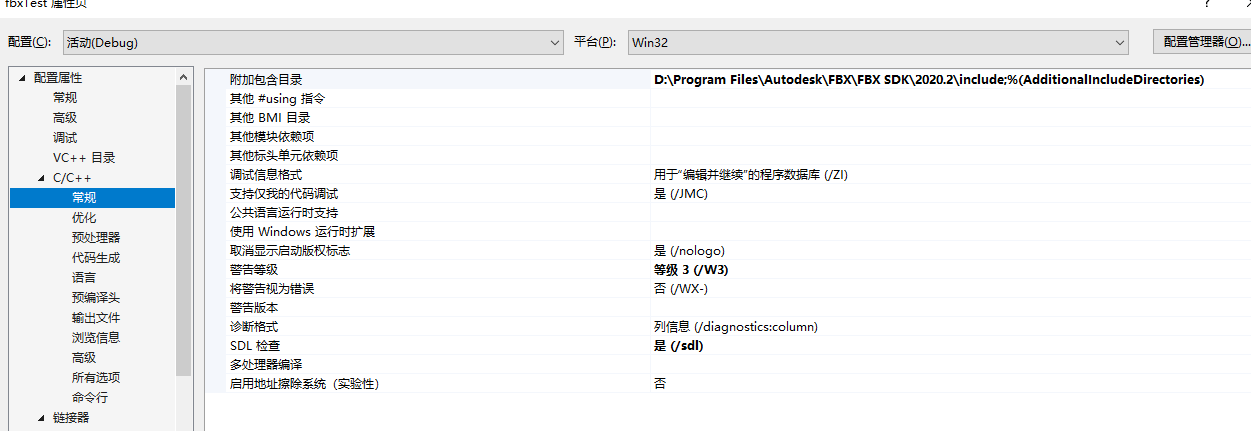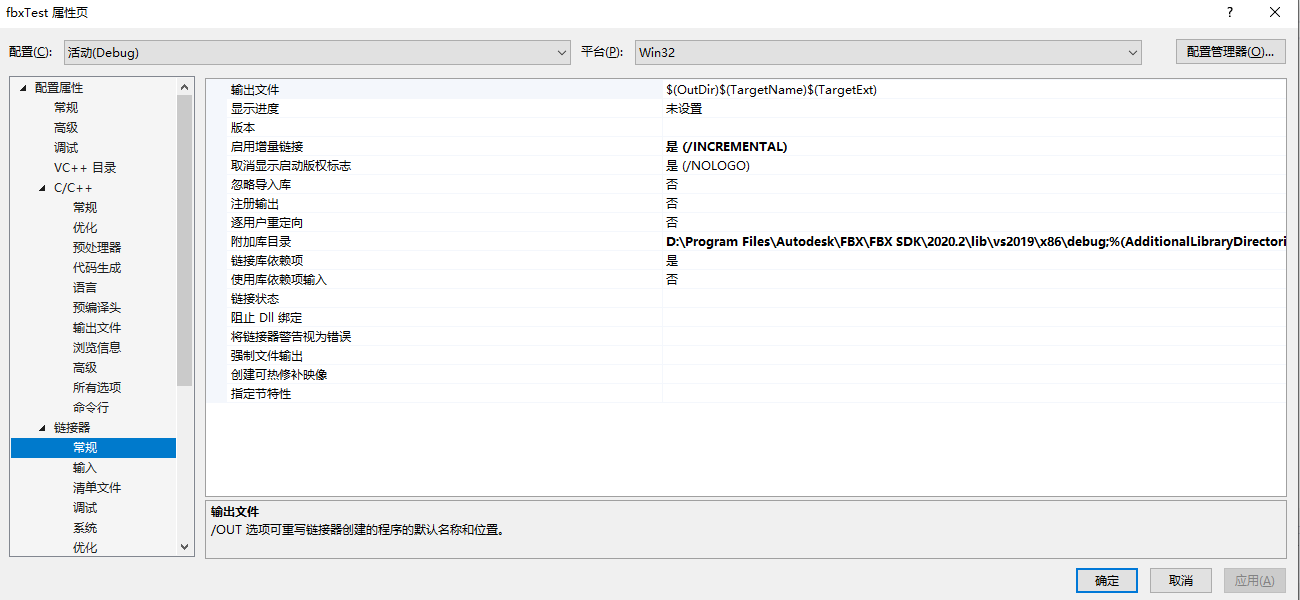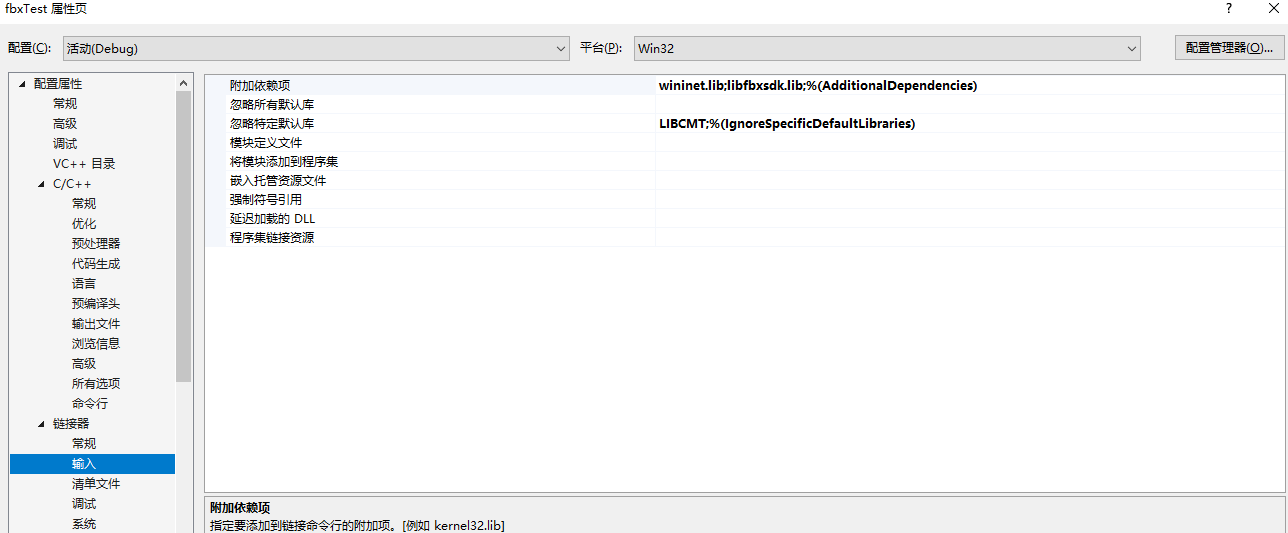https://zhuanlan.zhihu.com/p/361103783
fbx sdk配置
vs2019 / fbx sdk 2020.2



代码
记录一下,add vertexcolor卡了我好久
#include <fbxsdk.h>
#include <string>
using namespace fbxsdk;
using namespace std;
void StoreNormalsToVertColor(FbxNode* node)
{
if (node->GetChildCount())
{
for (int i = 0; i < node->GetChildCount(); i++)
{
if (node->GetChild(i)->GetMesh())
{
//获取mesh
FbxMesh* mesh = node->GetChild(i)->GetMesh();
int num_vertices = mesh->GetPolygonVertexCount();
// 如果不存在 自动生成切线 副切线
if (mesh->GetElementTangentCount() == 0 || mesh->GetElementBinormalCount() == 0)
{
mesh->GenerateTangentsData(0, true);
}
//获取layer,顶点色、法切线之类的顶点信息几乎存在layer中
fbxsdk::FbxLayer* layer0 = mesh->GetLayer(0);
//依次获取layer中的顶点色层、法线层、切线层、副法线(或者叫副切线)层
fbxsdk::FbxLayerElementVertexColor* VertColor = layer0->GetVertexColors();
//VertColor->SetMappingMode(FbxGeometryElement::eByControlPoint);
//VertColor->SetReferenceMode(FbxGeometryElement::eDirect);
fbxsdk::FbxLayerElementNormal* VertNormal = layer0->GetNormals();
fbxsdk::FbxLayerElementTangent* VertTangent = layer0->GetTangents();
fbxsdk::FbxLayerElementBinormal* VertBinomral = layer0->GetBinormals();
//逐顶点遍历操作
for (int j = 0; j < num_vertices; j++)
{
//声明一个整型数组,用于存放与当前遍历顶点同属一个控制点的顶点序列
//数组用的是FbxSdk内置的数组,是动态数组,比较好使
FbxArray<int> SameControlPointsIndex;
for (int k = 0; k < num_vertices; k++)
{
if (mesh->GetPolygonVertices()[k] == mesh->GetPolygonVertices()[j])
{
SameControlPointsIndex.Add(k);
}
}
//声明一个Vector4数组,获取并存放上面声明的顶点序列数组中所有不同方向的法线
//需要注意的是,与Unity的顶点不同,这里的顶点中有很多法线的方向是重复的
//如果将重复的法线也参与计算则算出来的值是错误的,轮廓线会扭曲,说出来都是泪
//所以使用AddUnique保证去掉重复的法线方向
FbxArray<FbxVector4> Normals;
for (int x = 0; x < SameControlPointsIndex.Size(); x++)
{
FbxVector4 Normal = VertNormal->GetDirectArray()[SameControlPointsIndex[x]];
Normals.AddUnique(Normal);
}
//将所有不同方向的法线加在一起并归一化获得光滑法线
FbxVector4 SmoothNormal;
for (int n = 0; n < Normals.Size(); n++)
{
SmoothNormal += Normals[n];
}
SmoothNormal.Normalize();
//分别获取当前顶点的切线、法线、副切线用于构建模型→切线空间的转换矩阵
//需要注意的是:法线、切线、副切线的映射方式(也就是存储方式)是与顶点
//序列一一对应,所以直接GetDirectArray()[顶点序号]就可以
FbxVector4 Tangent = VertTangent->GetDirectArray()[j];
FbxVector4 Normal = VertNormal->GetDirectArray()[j];
FbxVector4 Bitangent = VertBinomral->GetDirectArray()[j];
//FbxVector4 Bitangent = Normal.CrossProduct(Tangent) * Tangent[3];
//Bitangent.Normalize();
//将法线从模型空间转为切线空间
//FbxSdk的内置矩阵类型不会使,算出来的值有问题,所以还是手动计算
FbxVector4 tmpVector;
tmpVector = SmoothNormal;
tmpVector[0] = Tangent.DotProduct(SmoothNormal);
tmpVector[1] = Bitangent.DotProduct(SmoothNormal);
tmpVector[2] = Normal.DotProduct(SmoothNormal);
tmpVector[3] = 0;
SmoothNormal = tmpVector;
SmoothNormal.Normalize();
//获取当前顶点的颜色信息存放于其layer中的序号
//与法切副不同,顶点色数据在layer中的存储方式(映射Mapping方式)稍微复杂
//首先要使用GetIndexArray()[顶点序号]获取其颜色值在DirectArray中的序号
//然后使用GetDirectArray()[获得的序号]来获得该顶点的顶点色信息
int VertColorIndex = VertColor->GetIndexArray()[j];
//声明一个颜色值,将法线数值范围从-1~1处理为0~1后存入RGB通道中,A通道保持
//不变,因为其中存放着轮廓线大小信息
FbxColor color;
color.mRed = SmoothNormal[0] * 0.5f + 0.5f;
color.mGreen = SmoothNormal[1] * 0.5f + 0.5f;
color.mBlue = SmoothNormal[2] * 0.5f + 0.5f;
color.mAlpha = VertColor->GetDirectArray()[VertColorIndex].mAlpha;
//将颜色写入顶点颜色layer中
VertColor->GetDirectArray().SetAt(VertColorIndex, color);
}
}
//递归调用,确保场景中所有mesh都得到处理
StoreNormalsToVertColor(node->GetChild(i));
}
}
}
// 如果没有是顶点色 先手动添加
void AddVertColor(FbxNode* node)
{
if (node->GetChildCount())
{
for (int i = 0; i < node->GetChildCount(); i++)
{
if (node->GetChild(i)->GetMesh())
{
//获取mesh
FbxMesh* mesh = node->GetChild(i)->GetMesh();
int num_vertices = mesh->GetPolygonVertexCount();
auto LayerZero = mesh->GetLayer(0);
fbxsdk::FbxLayerElementVertexColor* VertexColor = fbxsdk::FbxLayerElementVertexColor::Create(mesh, "");
VertexColor->SetMappingMode(fbxsdk::FbxLayerElement::eByPolygonVertex);
VertexColor->SetReferenceMode(fbxsdk::FbxLayerElement::eIndexToDirect);
FbxLayerElementArrayTemplate<FbxColor>& VertexColorArray = VertexColor->GetDirectArray();
FbxLayerElementArrayTemplate<int>& VertexIndexArray = VertexColor->GetIndexArray();
LayerZero->SetVertexColors(VertexColor);
for (int VertIndex = 0; VertIndex < num_vertices; VertIndex++)
{
VertexColorArray.Add(FbxColor(1, 0, 0, 1));
VertexIndexArray.Add(VertIndex);
}
}
//递归调用,确保场景中所有mesh都得到处理
AddVertColor(node->GetChild(i));
}
}
}
int main(int argc, char** argv) {
for (int i = 1; i < argc; i++)
{
/*string name = argv[i];
string name_export = name.replace(name.find(".FBX"), 4, "_outline.FBX");
printf("%s \n", name_export.c_str());*/
// lFilename是输入路径,lFilename2是输出路径
//const char* lFilename = "C:\\Users\\LilithGames\\Desktop\\dsadas.FBX";
//const char* lFilename2 = "C:\\Users\\LilithGames\\Desktop\\export.FBX";
char* lFilename = argv[i];
char* lFilename2 = argv[i];
//主函数中几乎都是FbxSdk文档中所写的代码,是导入导出fbx所需要的的标准流程
// Initialize the SDK manager. This object handles all our memory management.
FbxManager* lSdkManager = FbxManager::Create();
// Create the IO settings object.
FbxIOSettings* ios = FbxIOSettings::Create(lSdkManager, IOSROOT);
lSdkManager->SetIOSettings(ios);
// Create an importer using the SDK manager.
FbxImporter* lImporter = FbxImporter::Create(lSdkManager, "");
// Use the first argument as the filename for the importer.
if (!lImporter->Initialize(lFilename, -1, lSdkManager->GetIOSettings())) {
printf("Call to FbxImporter::Initialize() failed.\n");
printf("Error returned: %s\n\n", lImporter->GetStatus().GetErrorString());
exit(-1);
}
// Create a new scene so that it can be populated by the imported file.
FbxScene* lScene = FbxScene::Create(lSdkManager, "myScene");
// Import the contents of the file into the scene.
lImporter->Import(lScene);
// The file is imported; so get rid of the importer.
lImporter->Destroy();
//获取场景中根节点,然后对其调用自定义的StoreNormalsToVertColor函数
FbxNode* lRootNode = lScene->GetRootNode();
if (lRootNode) {
AddVertColor(lRootNode);
StoreNormalsToVertColor(lRootNode);
}
//导出Fbx文件
int lFormat = lSdkManager->GetIOPluginRegistry()->FindWriterIDByDescription("FBX ascii (*.fbx)");
lFormat = -1;
FbxExporter* lExporter = FbxExporter::Create(lSdkManager, "");
bool lExportStatus = lExporter->Initialize(lFilename2, lFormat, lSdkManager->GetIOSettings());
if (!lExportStatus) {
printf("Call to FbxExporter::Initialize() failed.\n");
printf("Error returned: %s\n\n", lExporter->GetStatus().GetErrorString());
return false;
}
lExporter->Export(lScene);
lExporter->Destroy();
// Destroy the SDK manager and all the other objects it was handling.
lSdkManager->Destroy();
}
return 0;
}